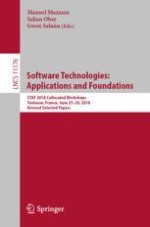This book contains the thoroughly refereed technical papers presented in eight workshops collocated with the International Conference on Software Technologies: Applications and Foundations, STAF 2018, held in Toulouse, France, in June 2018.
The 65 full papers presented were carefully reviewed and selected from 120 submissions.
The events whose papers are included in this volume are:
CoSim-CPS 2018: 2nd International Workshop on Formal Co-Simulation of Cyber-Physical Systems
DataMod 2018: 7th International Symposium From Data to Models and Back
FMIS 2018: 7th International Workshop on Formal Methods for Interactive Systems
FOCLASA 2018: 16th International Workshop on Foundations of Coordination Languages and Self-adaptative Systems
GCM 2018: 9th International Workshop on Graph Computation Models
MDE@DeRun 2018: 1st International Workshop on Model-Driven Engineering for Design-Runtime Interaction in Complex Systems
MSE 2018: 3rd International Workshop on Microservices: Science and Engineering
SecureMDE 2018: 1st International Workshop on Security for and by Model-Driven Engineering
